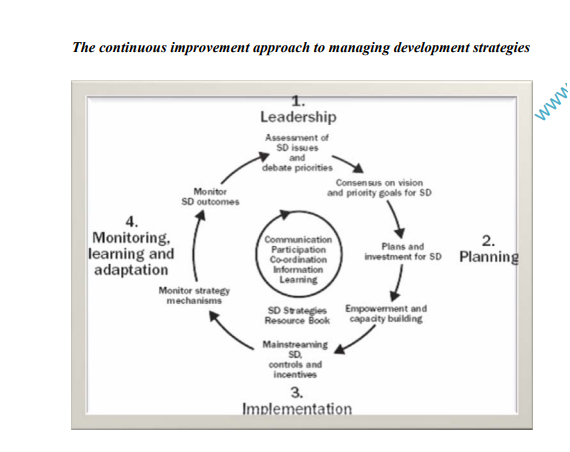National development strategies over the last few years have identified strategic management as a new pattern of governance and policy making. Being strategic entails developing an underlying vision through consensual, effective and iterative process; and going
on to set objectives, identify the means of achieving them, and then monitor the achievement as a guide to the next round of this learning process.
It also entails shifting grand planning schemes to adaptive strategy processes, from authorities to competencies, from pure hierarchies to a combination of hierarchies and networks, from control to monitoring, evaluation and feedback, and from knowing to learning
are promising steps in the right direction. The success of this shift is typically a function of process aspects such as leadership,
planning, implementation, and monitoring and review. The latter represent some of the fundamental tenets of strategic management.

Leadership – “developing an underlying vision through consensual, effective and iterative process; and going on to set objectives”. Leadership is perhaps the most critical aspect of strategic management. Through a consultative process, it provides the vision for development activities and services. At its foundation, leadership must be grounded in the fundamental principles of sustainable development, that is, it must represent both existing and future generations, and it must understand the interdependency among economic, social and environmental systems. It requires identification of:
- Type of strategy approach
- Demonstrating commitment and focus
- Incorporating the inter-generational SD principle
- Incorporating the interdependency SD principle
Some of the characteristics of leadership include the following:
- people-centered approach;
- strong political commitment;
- consensus and long-term vision;
- sound leadership and good governance;
- comprehensive and integrated (economic, social, and environmental; intergenerational consideration);
- shared strategic and pragmatic vision;
- comprehensive and reliable analysis;
- linking short-term to medium and long-term;
- country led and nationally owned;
- effective participation; and
- Realistic and flexible targets.
Planning – identifying the means of achieving objectives (institutional mechanisms, programmatic structures and specific policy initiatives). It requires identification of:
- Legal basis
- Institutional basis
- Policy assessment
Implementation – employing and financing a mix of policy initiatives Monitoring, learning and adapting – development, monitoring and reporting of indicators to measure:
- Progress in implementing policy initiatives
- The economic, social and environmental state of the nation.
- Also includes formal and informal feedback mechanisms to ensure that monitoring results continually inform the adaptation of leadership, planning and implementation.
Approaches for the Strategy Process
Comprehensive, multi-dimensional SD strategy
A single document and process that incorporates economic, social and environmental dimensions of SD. This approach is most commonly associated with the term National
Sustainable Development Strategy. The national strategy provides a long-term perspective of the key SD challenges facing the country, and presents options for addressing priority issue areas. The strategy is described as a catalyst for change, and provides a framework to guide policy development and decision making.
Cross-Sectoral SD strategies relating to specific dimensions of SD
A strategy that spans multiple sectors and covers one or two dimensions of sustainable development, e.g., national environmental management plans or poverty reduction strategy papers (PRSPs). PRSPs describe a country’s macroeconomic, structural, and social policies in support of growth and poverty reduction, as well as associated external financing needs and major sources of financing.
Sectoral SD strategies
A strategy that incorporates economic, social and environmental dimensions of SD, but that is focused on a specific sector. Rather than create a single, national strategy for the government, responsibility for sustainable development to individual government departments and agencies (e.g., SD strategy for a ministry of transportation).
Guiding Principles of Sustainable Development Strategies
- Primacy of Developing Full Human Potential;
- Holistic Science and Appropriate Technology;
- Cultural, Moral and Spiritual Sensitivity;
- Self-Determination;
- National Sovereignty
- Gender Sensitivity;
- Peace, Order and National Unity;
- Social Justice, Inter-, Intra-Generational and
- Spatial Equity;
- Participatory Democracy;
- Institutional Viability;
- Viable, Sound and Broad-Based Economic Development;
- Sustainable Population
- Ecological Soundness;
- Bio-geographical Equity and Community- Based Resource Management; and
- Global Cooperation.
